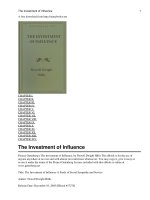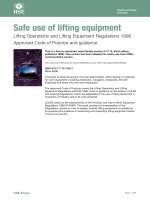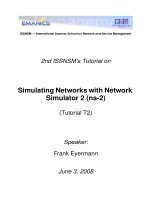Management ch 21 operations and service management
Bạn đang xem bản rút gọn của tài liệu. Xem và tải ngay bản đầy đủ của tài liệu tại đây (290.03 KB, 27 trang )
Chapter 21
Operations and Service Management
Operations and Service Management
Strategic
success depends on
efficient operations
Operational
concerns take on even
greater importance in today’s
competitive environment where
consumers often want customized
products and services delivered
immediately
Manager’s Challenge: Donnelley
2
Copyright © 2005 by South-Western, a division of Thomson Learning. All rights reserved.
Operations and
Service Management
3
Topics
Chapter 21
Management and control of production operations
Define operations management
How to bring operations into strategic decision
making
Overview of integrated operations activities
Specific operations design issues
How managers measure and improve productivity
Copyright © 2005 by South-Western, a division of Thomson Learning. All rights reserved.
Operations Management
The
field of management that specializes
in the physical production of goods or
services and uses quantitative techniques
for solving manufacturing problems
Technical core = heart of the
organization’s production of its product
or service
4
Copyright © 2005 by South-Western, a division of Thomson Learning. All rights reserved.
The Organization as an Operations
Management System
Feedback
Operations Strategy
Inputs
Raw materials
Human
resources
Land, buildings
Information
Technology
Operations Management
Products & Facilities
Structure
Product design
Reporting relationships
Facilities layout
Teams
Capacity planning
Facilities location
Control Processes
Inventory management
Productivity
Quality
The Technical Core
5
Copyright © 2005 by South-Western, a division of Thomson Learning. All rights reserved.
Outputs
Products
Services
Manufacturing and Service
Organizations
Source: Based on Richard L. Daft, Organization Theory and Design (Cincinnati, OH: South-Western College Publishing, 1998), 130; and Byron J. Finch and Richard L. Luebbe, Operations
Management (Fort Worth, Texas: The Dryden Press, 1995), 50.
6
Copyright © 2005 by South-Western, a division of Thomson Learning. All rights reserved.
Operational Concerns for Manufacturing
and Service Organizations
Scheduling
Must
obtain materials and supplies
Both must be concerned with quality
and productivity
7
Copyright © 2005 by South-Western, a division of Thomson Learning. All rights reserved.
Four Stages of Operations Strategy
Stage 1
No Involvement
• No positive
contribution to
strategy
formulation
• Concerns:
Cost
Labor efficiency
Stage 2
Industry Current
• Goals set according
to
industry
practice
• Concerns:
Capital investment
Quality control
Inventory
management
Capacity
Stage 3
Organizationally
Supportive
• Organization’s
competitive strategy
closely followed and
supported
• Concerns:
Advanced process
technologies
New plants
What to make for the
United States
Stage 4
Initiates Competitive
Advantage
• Advanced
capabilities
developed and
significant input to
strategic process
provided
• Concerns:
New products
New services
New technologies
International
Source: Based on R.H. Hayes and S.C. Wheelwright, Restoring Our Competitive Edge: Competing through Manufacturing (New York: Wiley, 1984).
8
Copyright © 2005 by South-Western, a division of Thomson Learning. All rights reserved.
The Integrated Enterprise
Supply
chain management = managing
the sequence of suppliers and
purchasers, covering all stages of
processing from obtaining raw materials
to distributing finished goods to final
consumers
9
Copyright © 2005 by South-Western, a division of Thomson Learning. All rights reserved.
The E-Supply Chain
Customer
Supplier
Extranet
Data
Exchange
Manufacturer
Extranet
Data
Exchange
Retail
Chain
Retail
Store
Intranet Data Exchange
Partnership approach to the supply chain optimizes inventory
levels and enables rapid response to customer needs
10
Copyright © 2005 by South-Western, a division of Thomson Learning. All rights reserved.
How to Win Customers?
Better
price
Quality
Performance
Delivery
Responsiveness to customer demand
11
Copyright © 2005 by South-Western, a division of Thomson Learning. All rights reserved.
Design for Manufacturability
and Assembly - DFMA
Often
–
–
12
requires
Restructuring operations
Creating teams of designers,
manufacturers, and assemblers to meet
objectives of design
Copyright © 2005 by South-Western, a division of Thomson Learning. All rights reserved.
Product Design Objectives
13
1
Producibility
2
Cost
3
Quality
4
Reliability
Copyright © 2005 by South-Western, a division of Thomson Learning. All rights reserved.
Service Design Objectives
1
Producibility
2
Cost
3
Quality
4
Reliability
5
Timing
Ethical Dilemma: A Friend for Life?
14
Copyright © 2005 by South-Western, a division of Thomson Learning. All rights reserved.
Procurement
Purchasing
supplies, services, and
raw materials for use in the
production process
15
Copyright © 2005 by South-Western, a division of Thomson Learning. All rights reserved.
Facilities Layout
Process
Layout
Product Layout
Cellular Layout
Fixed-position Layout
16
Copyright © 2005 by South-Western, a division of Thomson Learning. All rights reserved.
Technology Automation
Service
Technology
Restaurants
– calculate exact cost and ingredient
needs for each menu item
Banking – ATMs
Gas stations – pay-at-pump systems
Retailing = RFID – radio-frequency identification
(high-tech barcode)
17
Copyright © 2005 by South-Western, a division of Thomson Learning. All rights reserved.
Technology Automation
Flexible
Manufacturing Systems, the use of
automated production lines that can be quickly
adapted to produce more than one kind of
product
CAD/CAM
●
●
●
18
CAD = computer aided design
CAM = computer aided manufacturing
PLM = Product-life cycle management
Copyright © 2005 by South-Western, a division of Thomson Learning. All rights reserved.
Facility Location
Cost-benefit
analysis – most common
approach to selecting a site for a new
location
New
location scouting software is helping
managers turn facilities location into a
science
19
Copyright © 2005 by South-Western, a division of Thomson Learning. All rights reserved.
Capacity Planning
Determination
and adjustment of the
organization’s ability to produce
products and services to match
customer demand
20
Copyright © 2005 by South-Western, a division of Thomson Learning. All rights reserved.
Inventory Management
Finished goods inventory
Work-in-process inventory
Raw materials inventory
21
Copyright © 2005 by South-Western, a division of Thomson Learning. All rights reserved.
Techniques for Inventory
Management
Economic order quantity
Material requirements
planning
Just-in-Time inventory
systems
Logistics & Distribution
management
22
Copyright © 2005 by South-Western, a division of Thomson Learning. All rights reserved.
Logistics and Distribution
Management
Logistics
= activities required to physically
move materials into the company’s
operations facility and to move finished
products to customers
Distribution
= moving finished products to
customers (order fulfillment)
23
Copyright © 2005 by South-Western, a division of Thomson Learning. All rights reserved.
Material Requirements Planning - MRP
24
Dependent demand inventory planning and control
system
Schedules exact materials required
Is computer based
Based on precise estimates of future needs for
production
Copyright © 2005 by South-Western, a division of Thomson Learning. All rights reserved.
Lean Manufacturing and Productivity
Lean
manufacturing = process using
highly trained employees at every
stage of the production process to cut
waste and improve quality – employee
involvement is key
25
Copyright © 2005 by South-Western, a division of Thomson Learning. All rights reserved.









